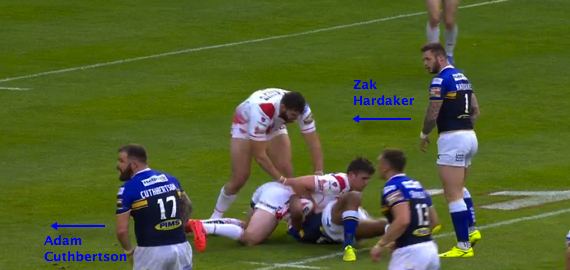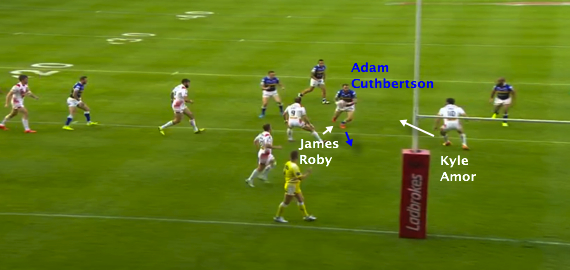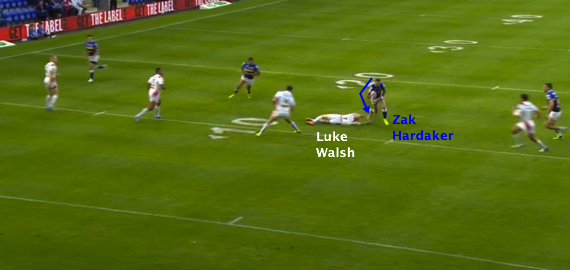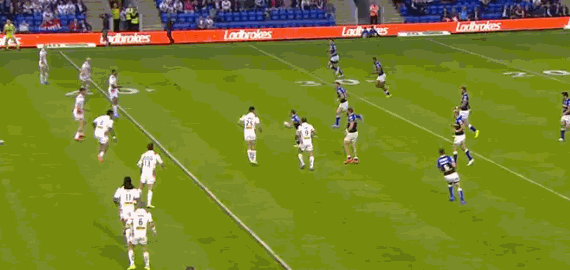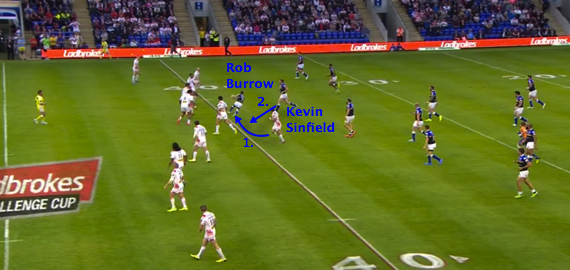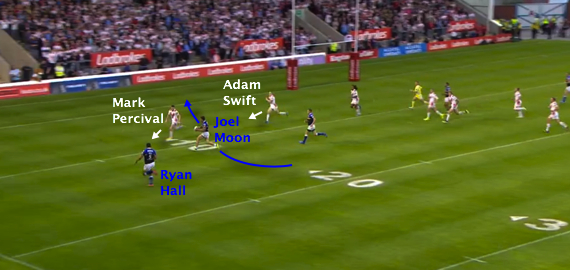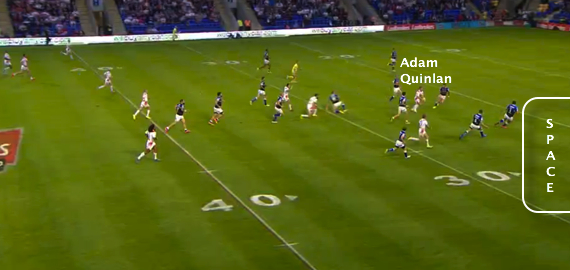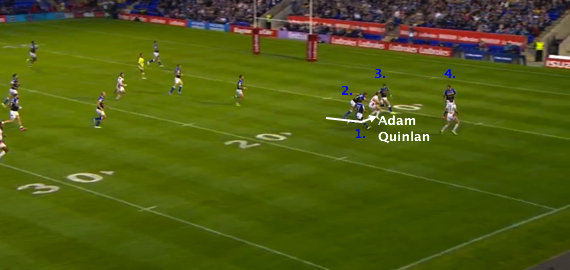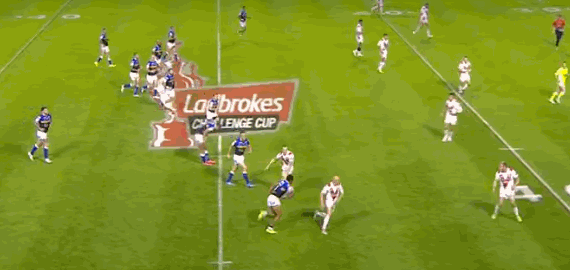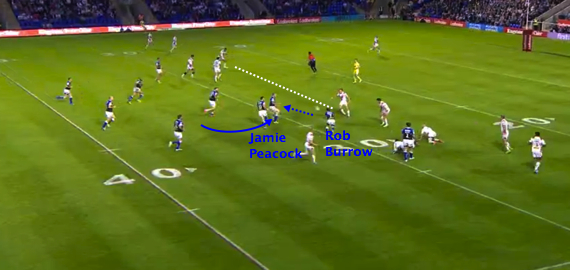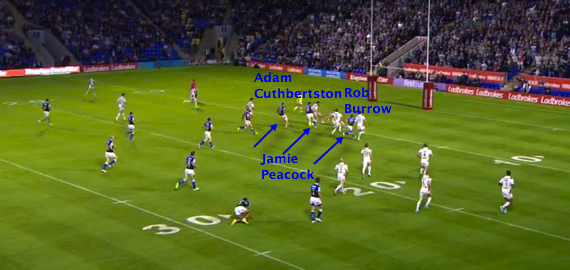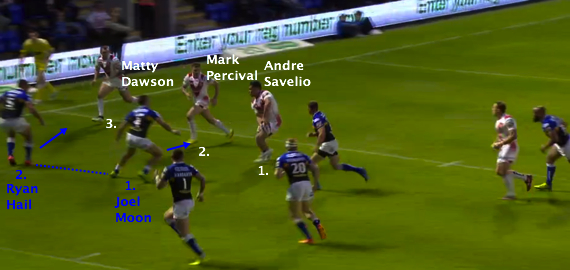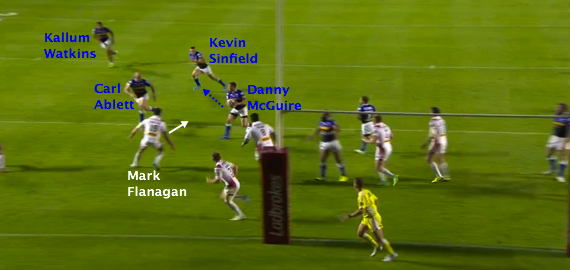Friday night's Challenge Cup semi-final between Leeds Rhinos and St Helens showcased attacking play that could be transferred from rugby league to union.
The crossover between 13- and 15-man codes is a well-trodden path. From coaches Phil Larder, Dave Ellis, Shaun Edwards and Mike Ford to megastar players Jason Robinson and Israel Folau, a plethora of rugby league personnel have made a significant impact on union.
It is a conveyor belt that does not look like slowing down either. Unless you have been living under a rock since Christmas, you will know that someone called Sam Burgess is honing in on a place in England’s World Cup squad.
Inevitably, a great deal of the copious chatter on Bath‘s former South Sydney Rabbitoh has centred upon his limitations and how a history in league has left him with much to learn.
During Friday evening’s Challenge Cup semi-final at the Halliwell Jones Stadium in Warrington though, Leeds Rhinos and St Helens reinforced a number of attacking principles that could easily be applied to union.
Skeptics might highlight league’s lack of contestable breakdowns and say that with a pristine platform, 10 metres of space and four fewer players on the pitch there is far greater scope for offensive success. In a sense, they would be correct.
But the ambition, execution and skill level of each side within their sport’s six-tackle framework was wonderful to watch. Here is a list of pointers that translate across the great divide from an excellent match.
1. Art of the offload
Passing out of contact is a key crowd-pleaser offered by code-hoppers. The Hollywood efforts of Sonny Bill Williams, often out the back of his hands, are sure to be a big feature of New Zealand‘s approach over the next couple of months.
By half-time of a 24-14 victory over St Helens, Leeds had racked up 17 offloads. For context, the Highlanders managed six more in the entirety of their harum-scarum Super 15 final triumph.
Big, bearded Australian front-rower Adam Cuthbertson was a pivotal figure here. Watch his role in the build-up to Leeds’ opening try:
Breaking this down step-by-step, we can see both Cuthbertson and full-back Zac Hardaker sizing up the St Helens defence at the play-the-ball:
Next up is Cuthbertson’s carry. Rather than crudely attempting to trample an opponent, he uses some footwork and aims at the gap between James Roby and Kyle Amor:
This makes it tougher for the tacklers either to get a decent contact with their shoulders or to wrap up the ball. Cuthbertson fights to free his right arm and flips it back to Paul Aiton amid the attentions of Roby and Amor:
From the reverse angle, we can see that five St Helens players are tied into a crowded point of contact:
Of course, Cuthbertson’s offload transfers the ball away and allows Leeds to probe elsewhere.
2. Exploiting a mismatch
Often union teams look to take advantage of a a disparity in speed or size – a fleet-footed centre rounding a prop in the defensive line, for instance. League is no different, as Hardaker’s finish demonstrated:
Throughout the evening, Leeds ran extremely hard down the channel of Luke Walsh, St Helens’ scrum-half. Weighing 83 kilograms, he was considered a weakness.
This time, the ploy pays off as Hardaker straightens up…
…and beats his man:
Leeds were just getting started.
3. Instinctive responses
An early injury to Aiton hastened the introduction of Rob Burrow. The diminutive playmaker lacerated Saints pretty quickly:
Again, a snapshot of the ruck is telling. Before bending to pick up the ball, Burrow assesses his options:
As he takes off, it is worth taking note of Kevin Sinfield‘s positioning. The Yorkshire Carnegie-bound stand-off is lurking on Burrow’s right:
Sprinting into open space, Burrow’s line of running is interesting. He curves back away from the defence, much like a union scrum-half might from the base of a breakdown.
Just as wings adjust to link up with All Blacks number nine Aaron Smith, Sinfield responds accordingly and cuts underneath his teammate:
As Burrow makes a half-break, Sinfield appears on his left shoulder:
Watching the telepathic link-up from the opposite viewpoint really underlines the notion that offloading is as much about reactive support play as anything else:
What came next was just as impressive.
4. Clinical composure in broken field
As England have found all too often in recent times, creating and finishing off a line-break are two very different concepts. Leeds had no such trouble here:
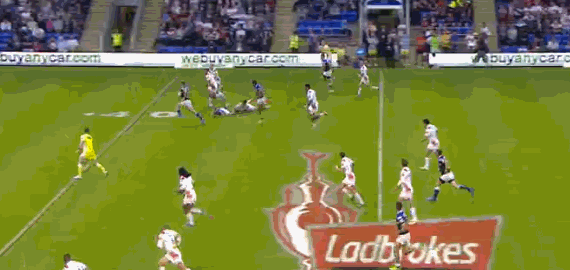
Centre Kallum Watkins was dangerous all night. His evasion to escape Atelea Vea is crucial:
A looping pass to Joel Moon then requires spatial awareness:
With wing Ryan Hall retaining width on the left and Saints scrambling desperately, Moon is presented with a two-on-one situation.
Reading that Mark Percival is drifting off him to Hall, he throws a dummy and beats covering Adam Swift to the whitewash:
This is almost mechanical in its ruthless efficiency. However, Saints hit back before the break.
5. Decision-making and option-taking
Split-second decisions underpin every sport and Percival’s first try brought an explicit example of selecting options under pressure.
Before anything else, a burly carry and deft offload from Alex Walmsley opened things up:
Despite finding the 105-kilogram frame of Jamie Peacock on his back, Walmsley’s two-handed offload to Adam Quinlan is flawless:
And this is where Quinlan’s brain starts whirring. Faced with four defenders, he has just Percival for company. At first, he looks as if he is weighing up a grubber-kick in behind for his colleague to chase:
Then there is a change of heart. Given St Helens were only on their third tackle and there is obviously no danger of getting isolated from support in the absence of contested breakdowns, it would perhaps be overindulgent to praise Quinlan too much for keeping the ball in hand.
That said, his movement and timing of pass is impeccable.
6. Drawing defenders
Straightening up before stepping off his right foot – all the time holding the ball in two hands – he sucks in all the defenders in his vicinity:
In the instant Hall turns his shoulders towards Quinlan, the pass is made and Percival has an easy walk-in:
The game’s next try was less about intricacies and more about sheer industry.
7. Off-the-ball opportunism
If Percival gave Saints a sniff, the most popular four-pointer of the match – a spectacular burst by veteran Peacock – hauled Leeds back into the ascendancy:
Now, the 30-metre charge is excellent in itself, but watch where Peacock is positioned when Watkins dances ahead:
Significantly, St Helens powerhouse Vea had left the field just seconds before this run due to a knee ligament injury.
The Tongan’s presence was missed immediately, and Peacock capitalised on a gaping hole in the middle of the field by coming from deep:
As if to emphasise the work ethic instilled and expected by Brian McDermott, both Burrow and Cuthbertson flood through the line to support Peacock:
Guile is little use without graft.
8. Striking on the short side
Stuart Lancaster often speaks of ‘two-sided attack’ – essentially the ability for a team to threaten on either flank of any given breakdown.
Hitting back once more, Saints showed the confidence to take on a 15-metre channel:
Much the same as in union, it is the acting half-backs that call the shots. Indeed, Walsh is organising an open-side pattern at the play-the-ball as Roby swoops to collect:
However, Roby identifies an overlap and instigates a foray to the right instead:
A straightforward three-on-two is accomplished with minimum fuss. Andre Savelio holds onto the ball and takes it flat, attracting Moon towards him. Matt Dawson stays wide to keep Hall on his toes.
Between them, Percival streaks onto a short pass:
Reviewing the sequence again, it looks polished and decisive:
Leeds would have the final say, though.
9. Bringing the ball to the line
It made sense that Watkins scorched over for the match-clincher – all the more so because it came following a cohesive movement:
Now, shielding moves in the midfield are commonplace in union these days. Even so, the league lads still lead the way.
Danny McGuire incites it all by taking on the St Helens defence, holding Mark Flanagan, and firing a pass back to Sinfield behind the decoy line of Carl Ablett:
In the wake of Ablett’s run, Sinfield has plenty of space.
10. Hidden angles
It will be very intriguing to watch Sinfield in union, although given he turns 35 in September he has not allowed himself a great deal of time to progress.
Here, he oozes class, slipping in Watkins between Walsh and a flat-footed Jordan Turner:
Watkins’ run itself is interesting. Having lingering almost directly behind Sinfield, he catches Saints unsighted and they cannot halt his curve back against the grain:
The angle itself is somewhat reminiscent of Michael Hooper‘s effort against South Africa three weeks back:
As Phipps picks up, Hooper comes around the corner in the large shadow of James Horwill:
When Phipps then engages the fringe defence, Horwill attracts Lood de Jager and Cobus Reinach. Hooper can step out of his teammate’s slipstream and bundle over past Oupa Mohoje:
Both this score and that of Watkins came with around the 70-minute mark. That is no innocent coincidence. Deploying multiple runners in motion can be devastating when defences tire.
Whoever lifts the Webb Ellis Cup at Twickenham on October 31 will have offered exacting attacking accuracy as well as defensive resilience. Ticking off the 10 aspects above is a decent place to start for each of this autumn’s World Cup hopefuls.
If there is still a section of union supporters that believes rugby league is solely based on blown-up blokes biffing one another, they are truly misguided.







